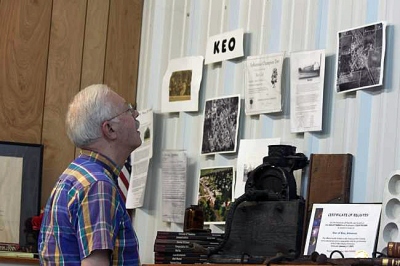National Register of Historic Places
By Sarah Morris
Posted Jul. 6, 2011 @ 12:01 am
Updated Jul 5, 2012 at 4:04 PM
Stuttgart, Ark.
In the 1950s, there wasn't a parking spot to be had on a Saturday in Keo. “It would be full of people,” Keo native Bodie Cobb said. “People who would live on the farms would come in and buy their groceries for the week.” The small town, which is at the tip of the southern delta, was in its hey day then. However, in the 1960s, the town began its slow descent as it took hits from changes in the region's transportation, agriculture and culture. It's grocery store, Bank of Keo, drug store, and general store all closed over the next three decades as people slowly began drifting out-of-town.
Today, the town is busiest at noon when locals and out-of-towners stop in for lunch at Charlotte's Eats and Sweets, which Charlotte Bowls of Keo opened in 1992. Cobb said the restaurant and Morris Antiques have both helped the town and its residents more than anything else. Mayor Nancy Cobb Tardy said she hopes to add one more item to the list: The town's new spot on the National Register of Historic Places. It's a listing that many consider a blessing.
“Most small delta towns are about to dry up and blow away,” Cobb said. “I just don't want Keo to be that way. If it wasn't for Charlotte's, that's what Keo would be like. The antique stores help because they bring in some business.”
The Keo Commercial Historic District was added to the national register for its cotton and rice farm history as well as its standard 20th century commercial buildings and early-to-mid century plain-traditional agricultural-industrial structures. Cobb said he originally sought the distinction for the old-fashioned cotton gin he previously managed with Ken Cole. According to the town's history, the gin produced 20 bales of cotton an hour while modern gins could produce 100 bales an hour. It went out of business in 2008.
The designation was broadened to encompass the Keo's commercial district after a state official came down to look at the gin and suggested including the businesses as well. The historic district now has 37 buildings listed, which have all been there since 1926. Janet Herring, who works near the historic district, said she believes more people will now visit Keo because of its new spot on the national register. It's what Tardy is counting on. The Keo native and mayor of nine years said she would be exploring the new possibilities that the designation brings to the table.
“You just have to find the right sort of niche. We're just looking,” Tardy said. One such way is by using it to expand the town's annual Fall Day, which changes themes each year. It is held on the first Saturday in October. They also hope to start a new event in the summer, although it is in the planning stages.
“We're in the very beginning of getting things together and getting it going,” Tardy said. “I think its neat. We're trying to rebuild. Every small town needs an influx of people.”
Keo's close proximity to Little Rock — about 24 miles — has helped it to gain some commuters to its ranks.
Tardy said about nine-tenths of the community's 256 residents work in Little Rock. “There is kind of a gap between the younger and older generations,” Tardy said. The young generation is mostly commuters who have moved to the community, while the older generation, including both Cobb and Tardy, are Keo natives. Tardy said it made her question on who would gather the town's history if she didn't.
However, the distinction has not only opened the community's eyes to what lies in the future, but also in the past. Tardy said she and Cobb are among the last of the old generation of natives who know the town's history. “We're trying to preserve our history,” she said.
Nine years ago, Tardy said the city hall was rearranged to include a lending library, pictures of past mayors and a history corner which shows the town's history since it applied for incorporation in 1909. The town's incorporation was finalized in 1916. The city hall also includes a collection of pictures of each World War II soldier that was from Keo, which the then-postmaster took and put together in the early 1940s. A star in the bottom corner designates those that died during the war or since then. With the distinction of being on the National Register of Historic Places only days old, Tardy and Cobb said the community has already received its first benefit: An in-depth town history. Previously, the community only had a two-page history put together after people kept asking about it while eating at Charlotte's Eats and Sweets.
Cobb said the history was first written down when he was in sixth grade at the former Keo school, which closed around 1950. “We probably worked on it all semester maybe,” Cobb said. “We talked to all of the older people in town. We're (Cobb and Tardy) the last now of the old people.” However, that history is not complete. Tardy, who is cousins with Cobb, said they are now collecting the names of people who have lived in the community in the past as well as any pictures and stories that people are willing to share.
“We discovered in doing this that we don't have a lot of pictures because back then people just didn't take pictures,” she said. She said they do not really have any pictures of the community from the 1950s to 1970s.
It's a factor that she hopes will soon be corrected.

